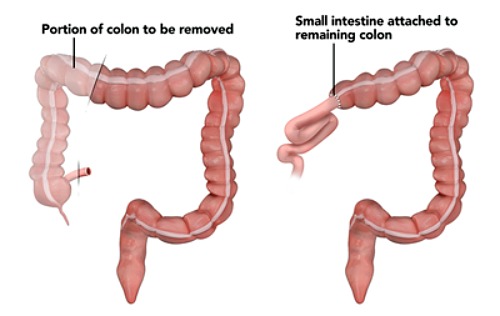Right Hemi-Colectomy

Right hemi-colectomy is a surgical procedure where the right portion of the colon (including the cecum, ascending colon, and part of the transverse colon) is removed. This right hemicolectomy surgery is commonly performed to treat conditions such as colon cancer, Crohn's disease, diverticulitis, or large polyps that are not amenable to endoscopic removal. The hemicolectomy operation is carefully planned to ensure optimal results for patients, particularly when performed by the best doctors for colon cancer treatment in Ahmedabad.
Indications
- Colon cancer
- Crohn's disease
- Diverticulitis
- Benign polyps
- Intestinal obstruction
Preoperative Considerations
- Patient evaluation and staging (for cancer patients) before lap right hemicolectomy
- Nutritional assessment for right hemicolectomy in Gujarat
- Bowel preparation
- Preoperative antibiotics
- Discussion of surgical approach options with the patient, including extended right hemicolectomy
Surgical Approaches
1. Open Right Hemi-Colectomy
Procedure:
- Incision: A midline or right paramedian incision is made to access the abdominal cavity for right hemicolectomy surgery.
- Mobilization: The right colon is mobilized by dissecting the lateral peritoneal attachments in a hemicolectomy operation.
- Vascular Control: The ileocolic, right colic, and right branches of the middle colic vessels are identified, ligated, and divided.
- Resection: The affected segment of the colon is resected, especially in cases of right hemicolectomy in Ahmedabad.
- Anastomosis: The ileum is anastomosed to the transverse colon, either in a hand-sewn or stapled fashion.
- Closure: The abdominal cavity is inspected, hemostasis is achieved, and the incision is closed.
Advantages:
- Direct visualization and tactile feedback
- Easier for complex cases with extensive adhesions, like an extended right hemicolectomy
Disadvantages:
- Larger incision leading to more postoperative pain
- Longer recovery time
- Higher risk of wound complications
2. Laparoscopic Right Hemi-Colectomy
Procedure:
- Port Placement: Several small incisions are made for port placement, usually including one for the camera and others for surgical instruments in lap right hemicolectomy.
- Insufflation: The abdomen is insufflated with carbon dioxide to create a working space for best laparoscopic right hemicolectomy.
- Mobilization and Vascular Control: The colon is mobilized laparoscopically, and the vessels are ligated using energy devices or clips.
- Resection and Extraction: The colon is resected, and the specimen is usually removed through an extended port site or a small incision.
- Anastomosis: An intracorporeal or extracorporeal anastomosis is performed.
Advantages:
- Minimally invasive with smaller incisions in right hemicolectomy in Gujarat
- Reduced postoperative pain, especially in r hemicolectomy
- Shorter hospital stay
- Faster return to normal activities
Disadvantages:
- Technically demanding with a steep learning curve
- Limited tactile feedback
- Potential for conversion to open surgery
3. Robotic-Assisted Right Hemi-Colectomy
Procedure:
- Docking: The robotic system is docked after port placement similar to laparoscopic surgery, providing the best laparoscopic right hemicolectomy experience.
- 3D Visualization: The surgeon uses the robotic console to control the instruments with enhanced 3D visualization and precision.
- Mobilization and Vascular Control: The colon is mobilized, and the vessels are ligated with the robotic arms providing greater dexterity.
- Resection and Anastomosis: The resection and anastomosis are performed robotically, with the specimen extracted as in laparoscopic surgery.
Advantages:
- Superior precision and control, making it a popular choice for r hemicolectomy
- Enhanced visualization with 3D imaging
- Better ergonomics for the surgeon
- May offer benefits in complex cases (e.g., obese patients)
Disadvantages:
- High cost of robotic systems
- Longer operating times (especially in the initial phase of the learning curve)
- Requires specialized training and equipment
Postoperative Care
- Monitoring for complications (bleeding, infection, anastomotic leak) after righthemicolectomy
- Early ambulation
- Pain management
- Gradual return to diet
- Follow-up for pathology results (if resected for cancer) by the best doctors for colon cancer treatment in Ahmedabad
- Long-term monitoring for recurrence (cancer patients) or disease control (Crohn’s disease)
Complications
- General: Infection, bleeding, anastomotic leak, ileus
- Procedure-Specific: Incisional hernia (open), port-site hernia (laparoscopic/robotic), longer operative time (robotic)
Outcomes
- High success rate with low morbidity and mortality in experienced hands, particularly for right hemicolectomy in Ahmedabad
- Laparoscopic and robotic approaches generally result in faster recovery and reduced hospital stays
- Oncologic outcomes are similar across the three approaches when performed adequately.
Conclusion
The choice between open, laparoscopic, and robotic right hemi-colectomy depends on various factors, including patient characteristics, surgeon expertise, and available resources. All three approaches have their unique advantages and challenges, but minimally invasive techniques (laparoscopic and robotic) are increasingly favored due to their associated benefits in recovery, making lap right hemicolectomy an effective solution.